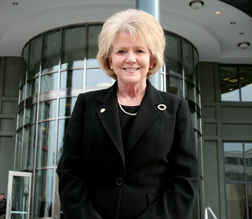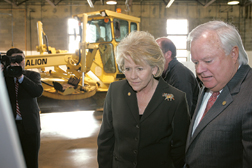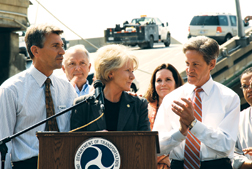
Guy Lawrence/ENR Mary Peters
|
It’s a chilly late January morning and U.S. Transportation Secretary Mary E. Peters is in Montgomery, Ala., speaking bluntly about the need to revamp the nation’s highway program. At a press conference in a state transportation department maintenance shop, Peters praises Gov. Bob Riley (R), who’s standing nearby, for seeking to get the private sector more involved in road projects. Then she blasts the way the program operates now, declaring, “I have…zero confidence zero that if we send more money to Washington we’ll get any better results back.” .
Surface transportation programs stand at a critical juncture. Roads, bridges and transit lines are aging and construction costs rising. But the Highway Trust Fund, the prime federal-aid source for such infrastructure, is projected to show a $3.2-billion shortfall in its highway account in the fiscal year that starts Oct. 1 and cannot cover spending increases public works advocates want. As programs speed toward this crossroads, big questions loom: Which way should the programs turn? Who should pay for the trip?
The debate is Topic A in transportation circles and Peters, DOT’s chief since September 2006, is in the thick of it. Things are heating up. Congress may well repair the projected trust fund “hole,” but the patch would be temporary. A longer-range solution might be needed as early as fall 2009, when a major new transportation bill is due to replace the current statute, 2005’s SAFETEA-LU the Safe, Accountable, Flexible, Efficient Transportation Equity Act: A Legacy for Users.

D T/James Kim Peters studies Alabama highway plans with state DOT Director Joe McInnes.
|
The Bush administration’s term will end well before that new bill will be drafted, but Peters clearly doesn’t intend to just run out the clock. In fact, as her Alabama remarks show, she has become an increasingly vocal critic of the current federal role in funding and overseeing highway and transit infrastructure.
That became clear Jan. 15, when the National Surface Transportation Policy and Revenue Study Commission issued a study that was nearly two years in the making. Nine of the 12 commissioners issued a majority report, saying current annual spending is only 40% of the $225 billion to $340 billion they said is needed. To close the gap, they called for a 25¢-to-40¢-per-gallon hike in the federal fuels tax, plus more tolls, private-sector help, new transit and passenger-rail fees and increased funds from states.
But Peters, who chaired the commission, and two other panel members objected vociferously to the majority views. The gas-tax hike, which would represent up to a tripling of the current 18.4¢-per-gallon levy, was a big reason for Peters’ dissent. But her criticism is more fundamental, as she made clear in interviews with ENR on her recent trip to Alabama.
“I think that we should only do at the federal level what is truly in the national interest,” Peters says. “And everything else, we should offload down to the state and local level.” Along with that shift, she favors more public-private partnerships, tolling and traffic-pricing mechanisms to ease congestion.

Porter Novelli Peters champions public-private partnerships, such as California�s State Route 125 job.
|
Peters doesn’t think the federal government should get out of highways and transit altogether, but contends its role should be sharply reduced. In her view, federal responsibilities should include maintaining Interstate highways and other arterials, projects of national and regional significance, regulating highway safety and doing research in areas that benefit the national interest.
Role Reduction
“I think the federal government should collect and keep only that portion of the gas taxes that we’re collecting that meets those federal interest requirements, and the rest of it we should either give back to the states or never collect from the states to begin with so that it doesn't become federalized income,” she says.
Similarly, she says public transit is important and needs continued support. Peters believes a federal transit agency could have a role in setting security and safety standards, but she thinks states should decide which projects should go forward and have the flexibility to devote to transit whatever portion of their surface transportation funding they feel is appropriate.
Responding to emergencies also would be a federal job, based on Peters’ actions after last year’s Minneapolis bridge collapse. She flew to the scene the day after the accident, made two more trips in the next eight days, one of them with President Bush, and delivered $55 million in initial relief funds. She supported the $195 million Congress approved for the replacement bridge, but opposed adding funds for deficient bridges elsewhere. Congress disagreed, approving $1 billion.

THE U.S. NAVY/M C S S J A N Peters delivered federal money to Minnesota officials after Minneapolis bridge failure.
|
Peters, 59, has long been well-known in transportation circles. She led DOT’s Federal Highway Administration from 2001 to 2005. Before that, the Arizona native spent 16 years at her home state’s DOT. She started as a secretary, and rose to be director for three years. “When I left, she was a slam dunk to replace me,” says Larry Bonine, ADOT director from 1993-1998. Before becoming DOT Secretary, she was a senior vice president with Omaha-based HDR.
Peters wasn’t always in transportation. When she and her husband, Terry, lived in Indiana, from 1967 to 1984, her jobs including working as a meatcutter on the “killing floor” at a slaughter house. As a union steward, she was involved in...

Post a comment to this article
Report Abusive Comment